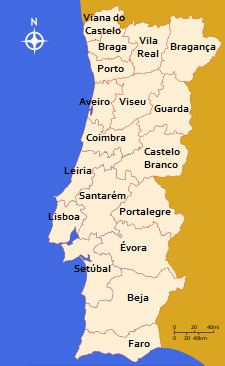Location Portugal Number 18 Areas 2,255–10,225 km² | Created 1835 Populations 127,018–2,135,992 | |
 | ||
Category 1st-level administrative division | ||
The Districts of Portugal (Portuguese: Distritos de Portugal), are the most important first-level administrative subdivisions of mainland Portugal. Currently, mainland Portugal is divided into 18 districts. The Portuguese autonomous regions of Açores and Madeira are no longer divided into districts.
Contents
- General
- Present purpose
- Azores
- Madeira
- Mainland Portugal
- Districts of the Portuguese Overseas
- Angola
- Mozambique
- Portuguese India
- References
As an administrative division, each district served mainly as the area of jurisdiction of a civil governor, who acted as the local delegate of the Central Government of Portugal.
General
The Portuguese Constitution of 1976 specifies that Portugal has only, as first level divisions, the autonomous regions (Azores and Madeira) and the administrative regions (to be created in mainland Portugal). According to the Constitution, the districts shall be disestablished in the territories where an autonomous or administrative region has been created.
So, the districts were abolished in Azores and Madeira when these autonomous regions were created, in 1976. In 1998, a proposal was submitted to referendum to create eight administrative regions in mainland Portugal, and, therefore, to extinguish the districts. This proposal was rejected in the ballot and so the districts continued to exist in mainland Portugal. It is worth noting that, despite their abolition in the autonomous regions, the areas of the three former districts of Azores are still used as areas of jurisdiction of some Government and non-government entities, like the district finance directorates (Tax Authority regional offices) or the district football championships.
However, the importance of the districts has been decreasing. In recent years, some administrative, financial and political competencies have been delivered to the CCDR's and to the municipalities, to the detriment of the districts. In 2003, the Portuguese municipalities were allowed to organize themselves into intermunicipal communities (comunidades intermunicipais) and metropolitan areas (áreas metropolitanas), which allowed for a lessening in the importance of the districts.
Besides, the abolition of the districts is a subject that came back for discussion in Portuguese society. In 2009, during the campaign for the legislative election of 2009, the leader of the Socialist Party, José Sócrates, promised a new referendum to the administrative regions and therefore, the abolition of districts, if he won the election. Other personalities support the creation of administrative regions and therefore the abolition of districts.
Nowadays, despite being in the process of being phased out due to the decentralisation policies of the government, the districts still remain the most relevant subdivision in the country, serving as a basis for a series of administrative divisions such as electoral constituencies, police and civil protection regional commands, sports district associations and championships.
In September 8, 2011, a decree from the Portuguese Government de facto extinguished all the offices of civil governor, transferring most of their functions to other bodies. As the existence of the civil governors is still included in the Portuguese Constitution, its de jure extinction can only be done after a constitutional amendment.
Present purpose
In mainland Portugal, for administrative purposes, the districts are still used as the areas of jurisdiction of the local branches and field offices of several Government ministries and agencies. Some of the bodies that have each district as their jurisdiction area are:
Furthermore:
For non-Government purposes, the districts are used as the area of jurisdiction of many entities, including:
Azores
Madeira
Mainland Portugal
Districts of the Portuguese Overseas
Following the model of European Portugal, the major Portuguese overseas territories (Angola, Mozambique and Portuguese India) were also divided in districts. In these territories, each district was headed by a district governor, subordinated to the governor-general. In Angola and Mozambique, the former district areas mostly coincide with the modern province areas. In the former Portuguese India, the Damão and Diu districts are still divisions of the present union territory of Daman and Diu, while the present state of Goa (former Goa District) is now divided in two districts.
